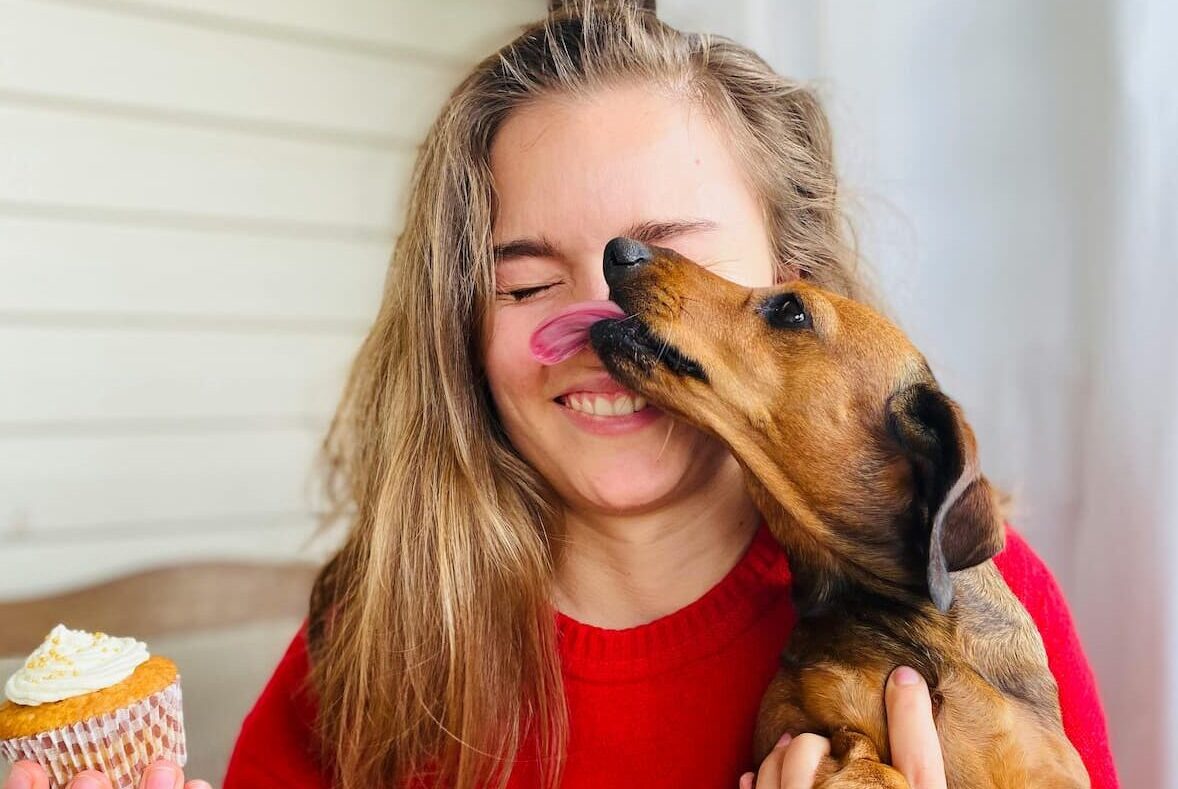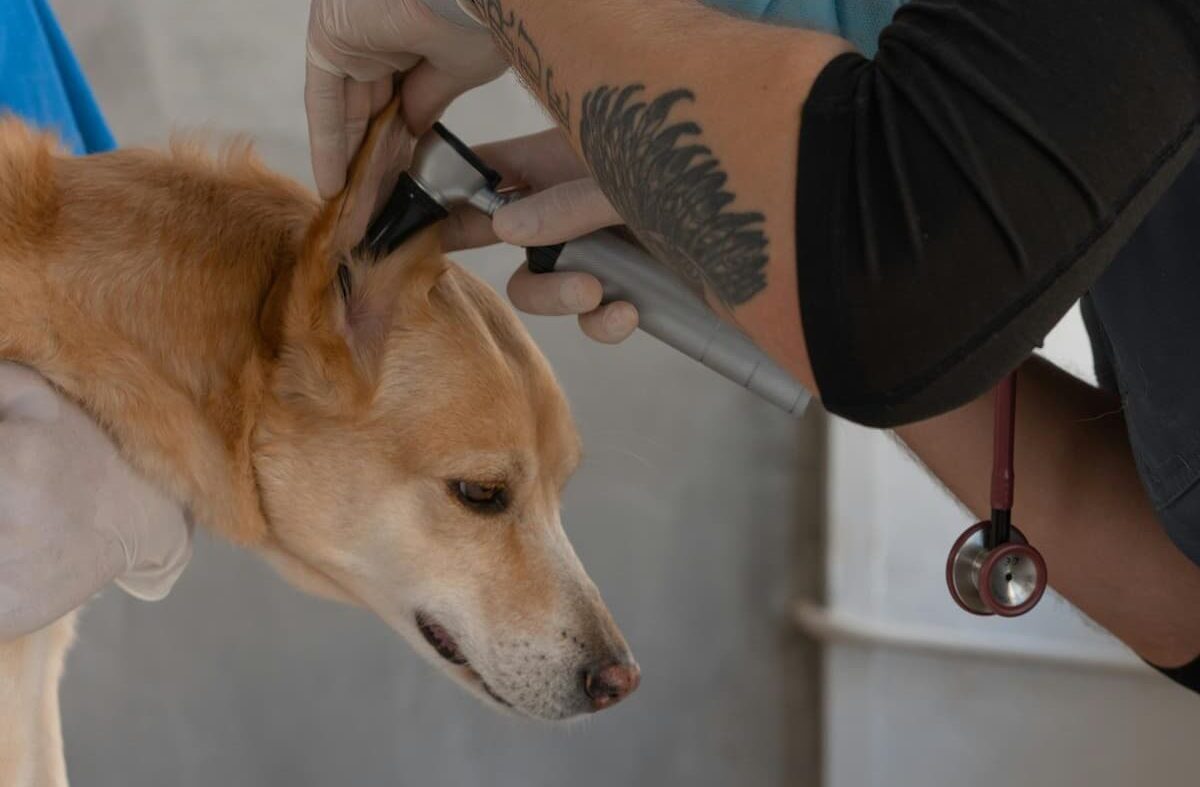Picture this: you’re sitting on the couch, engrossed in a book, when suddenly, your furry friend comes bounding over, tail wagging, ready to shower you with affection.
As you lean in for a cuddle, your dog’s wet tongue darts towards your ear.
Ah, the unmistakable tickle of a slobbery ear lick!
It’s both amusing and endearing, but have you ever wondered why dogs are drawn to our ears like magnets?
Read on to find the answers.
Understanding The Role of Ear-Licking
Dogs have their own unique language when it comes to communication, and one interesting behavior that often leaves owners puzzled is ear licking.
You may have witnessed your furry friend vigorously licking another dog’s ears or even attempt to lick your own ears.
But why do dogs engage in this seemingly odd behavior?
Here are some of the roles ear-licking plays in canine communication:
1. Sign of affection: Licking is a natural way for dogs to show affection towards each other and their human companions.
It’s their way of saying, “I care about you!”
When a dog licks another dog’s ears, it can be a sign of bonding and friendship.
The ritual of ear-licking is often reciprocal, with both dogs taking turns in grooming each other’s ears.
So, the next time you catch your pup giving your other four-legged friend a good ear-cleaning, remember that it’s their unique way of expressing love.
2. Establishing hierarchy: Dogs are social animals and have a natural inclination towards establishing hierarchies within their pack.
Ear-licking can serve as a way for a dominant dog to assert its authority over a more submissive one.
By licking another dog’s ears, the dominant dog is showing its superiority and reminding the submissive dog of its place in the pecking order.
It’s a subtle yet effective way for dogs to maintain harmony and order within their social structures.
3. Seeking attention or alleviating stress: In some cases, dogs may lick ears as a way to seek attention or relieve stress.
Dogs have taste receptors on their tongues, and the act of licking releases endorphins, which can have a calming effect on their emotional state.
So, if your pup is feeling anxious or uncertain, they may resort to licking their own ears or yours to self-soothe.
Additionally, ear-licking can be a strategy to grab your attention and get you to shower them with affection or offer reassurance during times of unease.
4. Exploring scents and tastes: Dogs have a refined sense of smell, and their tongues are not only for tasting but also for gathering information about the world around them.
When they lick your ear, they are not only detecting the unique scent that is specific to you but also exploring different tastes and textures.
It’s their way of learning more about their environment and the people or animals they interact with.
How Licking Ears Builds Trust and Affection
Here’s a closer look at the science behind ear-licking and how it plays a vital role in building trust and affection between dogs and their human companions.
1. Communication through scent: Dogs have an incredible sense of smell.
By licking ears, they are essentially sniffing and tasting the unique scent of their human’s earwax.
Pheromones are secreted in the earwax, and these chemical signals provide dogs with a wealth of information about their human’s emotions, health, and even identity.
So, next time your pup is giving your ear a thorough lick, remember that they’re trying to understand and connect with you on a whole new level.
2. Strengthening the bond: Licking ears is a behavior deeply ingrained in a dog’s ancestral history.
In a pack setting, dogs lick each other’s ears as a gesture of submission, respect, and affection.
By extending this behavior to their human companions, they’re signaling a strong bond and their willingness to accept you as part of their pack.
This act of trust-building strengthens the emotional connection between dogs and their owners, fostering a sense of security and companionship.
3. Promoting physical and emotional well-being: It’s not just about communication and bonding.
Licking ears can also have a soothing effect on dogs.
The act of licking releases endorphins in their brain, creating a sense of relaxation and pleasure.
In turn, this can help reduce stress, anxiety, and even alleviate physical discomfort.
o, the next time your furry friend gives your ear a gentle lick, remember that they are not only trying to communicate and build trust, but also showing their love and concern for your well-being.
The Hygiene Aspect of Ear-Licking
Moreover, ear-licking can actually be a form of self-care for dogs.
Just like humans, dogs produce wax in their ears as a natural cleaning mechanism.
However, unlike humans, dogs lack the appendage we call a hand to efficiently remove this wax.
Therefore, dogs resort to their trusty tongues as a means of cleaning and maintaining the hygiene of their ears.
By licking their own ears, dogs are able to remove dirt, debris, and excess wax, keeping their ears healthy and preventing potential infections.
This ear-licking also helps maintain hygiene within the pack.
Dogs have an incredible sense of cleanliness, and they instinctively groom themselves and others.
By licking each other’s ears, dogs help remove dirt, debris, and even pests like fleas and ticks.
It’s like giving your buddy a well-deserved spa treatment!
Plus, this grooming behavior strengthens the sense of unity and cooperation within the pack, fostering a healthier and happier canine community.
In conclusion, while ear licking may seem like a peculiar habit, it serves various purposes in a dog’s daily life.
From self-care to social bonding, this natural grooming technique has both physiological and emotional significance.
So, the next time your furry friend indulges in a hearty ear-licking session, remember that it’s their way of staying clean, expressing affection, and possibly finding comfort.
FAQ
Q: Why do dogs have such a fascination with licking ears?
A: First things first, let’s clarify that dogs lick ears for various reasons, but the main one boils down to good old communication.
Remember, dogs are social creatures, just like us humans, and they use a whole repertoire of behaviors to express their emotions and intentions.
Licking ears is their way of sending messages, not to mention it feels pretty good to them too!
Q: So what are these messages, you ask?
A: Well, for starters, dogs often lick ears as a sign of affection or love.
Just like humans kiss or hug to show they care, dogs shower us with wet kisses, including those oh-so-adorable ear-licks.
By giving our ears a good lick, they are essentially saying, “Hey, I really like you, and I’m happy to be by your side!”
Q: Can licking ears also indicate submission or respect?
A: Absolutely!
Dogs see the world a bit differently than we do, and they have their own ways of showing respect and acknowledging dominance.
Licking someone’s ears can display submission, especially when directed towards an older or more dominant member of the family pack.
It’s like saying, “I respect you and acknowledge you as my leader.”
Q: Is there any scientific reasoning behind this behavior?
A: While there isn’t an extensive scientific body of research solely dedicated to ear licking (for obvious reasons), some experts believe that it goes back to a dog’s ancestral instincts.
In the wild, wolves and other canines often lick the ears of their pack members to engage in social bonding and reinforce their pack’s unity.
So, there could be some genetic influence behind this behavior.
Q: Can ear licking be a sign of anxiety or stress?
A: It certainly can be!
Dogs may resort to licking their own ears or even another dog’s ears when they’re feeling anxious or stressed.
Like humans biting their nails or twirling their hair, dogs may engage in repetitive behaviors to help soothe themselves.
If you notice excessive ear licking accompanied by other signs of anxiety, it might be a good idea to consult with a veterinarian to ensure your furry friend is feeling okay.
Q: Is there anything we should be mindful of when it comes to dog ear licking?
A: Absolutely.
While dog ear licking is generally harmless and part of their endearing nature, it’s essential to keep an eye on any excessive or compulsive licking.
If your dog starts showing signs of discomfort, pain, or if their ears seem red and inflamed, it’s time to pay a visit to your trusted vet since it might indicate an underlying issue like an ear infection.
Q: Any tips for handling ear licking?
A: Sure thing!
Teaching your dog a “leave it” or ”no lick” command can help establish boundaries.
Similarly, you can redirect their attention to a toy or treat whenever they start licking ears excessively.
Remember, positive reinforcement is key — reward your pup for obeying your command.
Lastly, keeping your dog’s ears clean and healthy can reduce the chances of any discomfort prompting excessive licking.
Q: Final thoughts on why dogs lick ears?
A: All in all, dogs lick ears as a way of showing love, respect, and often to establish social connections.
It’s an instinctual behavior that’s been passed down throughout generations and is a testament to the unbreakable bond we share with our four-legged pals.
As long as both parties are comfortable, enjoy the occasional ear licking session and relish in the undeniable affection dogs have for their human companions!
Closing Notes
It’s fascinating how something as simple as a wet, slurpy kiss can hold so much meaning and symbolism in the world of canine communication.
From their days as wild wolves to their journey as our most loyal companions, dogs have developed unique ways of expressing affection, trust, and even submission.
And what better way to do so than through the quirky act of ear licking?
Whether it’s a gentle nuzzle or an all-out slobbery assault, dogs perceive our ears as a “gateway” to bonding and companionship.
Through this seemingly odd behavior, they are able to connect with us on a deeper level, bridging the gap between their instinctual nature and our complex human world.
So next time your furry friend decides to shower your ears with their affection, remember that it’s their way of saying, “You mean the world to me!”
It’s their way of reminding us that despite their wagging tails and adorable antics, they have a rich history of communication that extends far beyond barks and growls.














